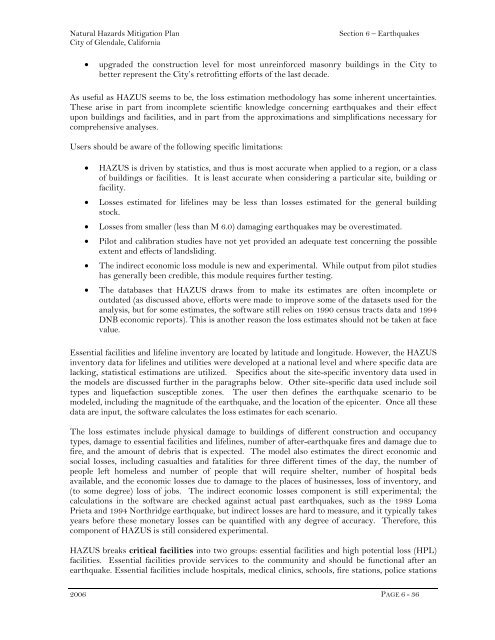Glendale (PDF) - Hazard Mitigation Web Portal - State of California
Glendale (PDF) - Hazard Mitigation Web Portal - State of California
Glendale (PDF) - Hazard Mitigation Web Portal - State of California
- No tags were found...
Create successful ePaper yourself
Turn your PDF publications into a flip-book with our unique Google optimized e-Paper software.
Natural <strong>Hazard</strong>s <strong>Mitigation</strong> PlanCity <strong>of</strong> <strong>Glendale</strong>, <strong>California</strong>Section 6 – Earthquakes• upgraded the construction level for most unreinforced masonry buildings in the City tobetter represent the City’s retr<strong>of</strong>itting efforts <strong>of</strong> the last decade.As useful as HAZUS seems to be, the loss estimation methodology has some inherent uncertainties.These arise in part from incomplete scientific knowledge concerning earthquakes and their effectupon buildings and facilities, and in part from the approximations and simplifications necessary forcomprehensive analyses.Users should be aware <strong>of</strong> the following specific limitations:• HAZUS is driven by statistics, and thus is most accurate when applied to a region, or a class<strong>of</strong> buildings or facilities. It is least accurate when considering a particular site, building orfacility.• Losses estimated for lifelines may be less than losses estimated for the general buildingstock.• Losses from smaller (less than M 6.0) damaging earthquakes may be overestimated.• Pilot and calibration studies have not yet provided an adequate test concerning the possibleextent and effects <strong>of</strong> landsliding.• The indirect economic loss module is new and experimental. While output from pilot studieshas generally been credible, this module requires further testing.• The databases that HAZUS draws from to make its estimates are <strong>of</strong>ten incomplete oroutdated (as discussed above, efforts were made to improve some <strong>of</strong> the datasets used for theanalysis, but for some estimates, the s<strong>of</strong>tware still relies on 1990 census tracts data and 1994DNB economic reports). This is another reason the loss estimates should not be taken at facevalue.Essential facilities and lifeline inventory are located by latitude and longitude. However, the HAZUSinventory data for lifelines and utilities were developed at a national level and where specific data arelacking, statistical estimations are utilized. Specifics about the site-specific inventory data used inthe models are discussed further in the paragraphs below. Other site-specific data used include soiltypes and liquefaction susceptible zones. The user then defines the earthquake scenario to bemodeled, including the magnitude <strong>of</strong> the earthquake, and the location <strong>of</strong> the epicenter. Once all thesedata are input, the s<strong>of</strong>tware calculates the loss estimates for each scenario.The loss estimates include physical damage to buildings <strong>of</strong> different construction and occupancytypes, damage to essential facilities and lifelines, number <strong>of</strong> after-earthquake fires and damage due t<strong>of</strong>ire, and the amount <strong>of</strong> debris that is expected. The model also estimates the direct economic andsocial losses, including casualties and fatalities for three different times <strong>of</strong> the day, the number <strong>of</strong>people left homeless and number <strong>of</strong> people that will require shelter, number <strong>of</strong> hospital bedsavailable, and the economic losses due to damage to the places <strong>of</strong> businesses, loss <strong>of</strong> inventory, and(to some degree) loss <strong>of</strong> jobs. The indirect economic losses component is still experimental; thecalculations in the s<strong>of</strong>tware are checked against actual past earthquakes, such as the 1989 LomaPrieta and 1994 Northridge earthquake, but indirect losses are hard to measure, and it typically takesyears before these monetary losses can be quantified with any degree <strong>of</strong> accuracy. Therefore, thiscomponent <strong>of</strong> HAZUS is still considered experimental.HAZUS breaks critical facilities into two groups: essential facilities and high potential loss (HPL)facilities. Essential facilities provide services to the community and should be functional after anearthquake. Essential facilities include hospitals, medical clinics, schools, fire stations, police stations2006 PAGE 6 - 36
















